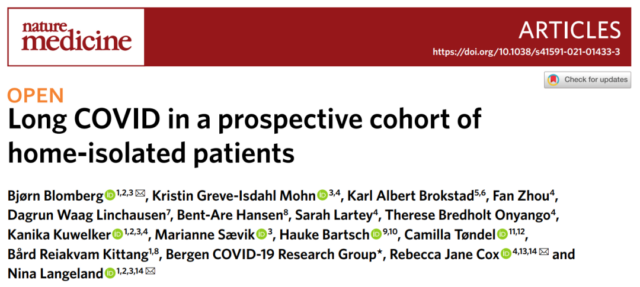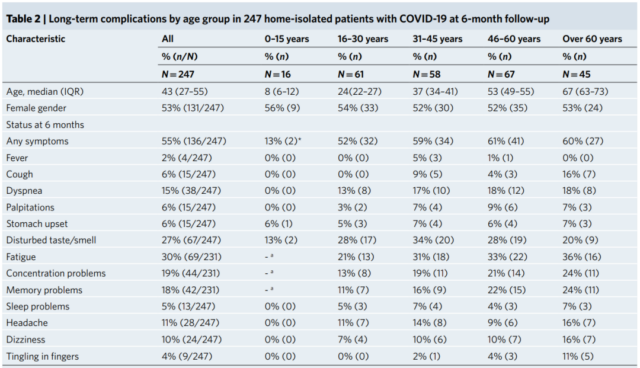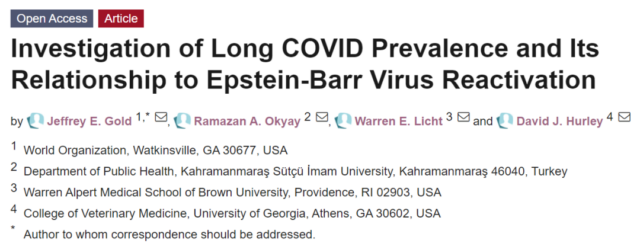More than half of COVID-19 patients still have sequelae after six months
- Aspirin: Study Finds Greater Benefits for These Colorectal Cancer Patients
- Cancer Can Occur Without Genetic Mutations?
- Statins Lower Blood Lipids: How Long is a Course?
- Warning: Smartwatch Blood Sugar Measurement Deemed Dangerous
- Mifepristone: A Safe and Effective Abortion Option Amidst Controversy
- Asbestos Detected in Buildings Damaged in Ukraine: Analyzed by Japanese Company
More than half of COVID-19 patients still have sequelae after six months of recovery: difficulty breathing, loss of taste and smell, fatigue, and decreased memory…..
More than half of COVID-19 patients still have sequelae after six months. Since the outbreak of the COVID-19 epidemic, it has continuously refreshed human’s understanding of the virus. As a “flying disaster” for the entire human race, the field and scope of its impact have also become larger and larger.
Obviously, the COVID-19 pandemic has caused immeasurable losses to the world economy and profoundly affected the social order of mankind.
The receptor for the new coronavirus, ACE2, is a receptor protein widely distributed in the human body, mainly in organs and tissues such as the respiratory tract, intestines, kidneys, heart, and testes. Therefore, the new coronavirus infection will not only cause illness and death, but also cause other complications, and cause sequelae of different degrees and symptoms after the patient recovers.
Not only that, the COVID-19 epidemic has also severely affected human reproductive health. Since the outbreak, many studies have shown that the kidneys and testes may be potential targets of the new coronavirus. Therefore, the new coronavirus infection may affect the reproductive health of human men.
More importantly, the COVID-19 infection can also cause sequelae, such as fatigue, dyspnea, joint pain, chest pain and even depression. Some critically ill patients still suffer from pulmonary fibrosis after recovery, which greatly affects the physical fitness and working ability of the recovered patients.
On December 2, 2020, Nature published an article titled: Could COVID delirium bring on dementia? It pointed out that the global pandemic of COVID-19 has caused many patients to develop delirium, which may lead to a surge in dementia patients around the world in a few years. .

Long-term complications after recovery from COVID-19 pneumonia are common in severely ill hospitalized patients, but most of the patients with COVID-19 infections are mild or asymptomatic infections. This “long COVID” (long COVID) affects mild to moderate patients, as well as asymptomatic infections. What kind of burden will be caused by the person? It has not yet been thoroughly studied and understood.
On June 23, 2021, Norwegian researchers published a research paper titled: Long COVID in a prospective cohort of home-isolated patients in the top international medical journal Nature Medicine.
A study conducted by the research team on 312 patients with COVID-19 pneumonia in Norway found that more than half of the young and middle-aged (16-30 years old) who were isolated at home experienced long-term continuous breathing difficulties and loss of taste and smell 6 months after the initial infection. , Fatigue or symptoms of inattention and memory loss.

In order to assess the long-term symptoms of patients with mild COVID-19 disease, Bjørn Blomberg and colleagues followed up 312 patients, who accounted for 82% of the first wave of cases in Norway.
This group includes 247 home-isolated individuals and 65 hospitalized patients, with a median age of 46 years and women accounting for 51%. The subjects went to the clinic to see a doctor and record their symptoms every two months.
After 6 months, 61% of patients developed persistent symptoms, and the symptoms were independently related to the severity of the initial illness.
61 home-isolated young adults (16-30 years old) still had 52% symptoms at 6 months. None of these young adults had symptoms such as fever or cough, but loss of taste and smell (28%) , Fatigue (21%), dyspnea (13%), impaired cognitive function (13%), memory loss (11%), dizziness (7%), stomach upset (5%), difficulty sleeping (5%) )and many more.
Of the 58 31-45-year-olds who were isolated at home, 59% had symptoms at 6 months.
Among the 67 46-60 year olds who were isolated at home, 61% had symptoms at 6 months.
Among the 45 people over the age of 60 who were isolated at home, 60% had symptoms at 6 months.

The author of the paper is concerned that some young people with mild illness who have not been hospitalized will continue to experience potentially severe symptoms for half a year after infection, and pointed out that the high incidence of persistent fatigue in COVID-19 patients is very striking, and the incidence seems to be higher than other common infections. For example, influenza and Epstein-Barr virus (EBV) mononucleosis are observed to be higher after recovery.
Considering that millions of young people have been infected in this unending epidemic, the author believes that it is necessary to carry out comprehensive infection prevention and control, universal vaccination, and further study the symptom spectrum of mild infections.
The reason for this “long COVID” (long COVID) is currently unclear.
However, on June 17, 2021, a study published in the Journal of Pathogens concluded that the inflammatory response caused by the new coronavirus infection caused the Epstein-Barr virus (EBV) to reactivate, which may cause the “long-term COVID-19 “(Long COVID) the cause of the symptoms. This is also the first study to link the reactivation of EBV with long-term COVID-19 symptoms.

(source:internet, reference only)
Disclaimer of medicaltrend.org
Important Note: The information provided is for informational purposes only and should not be considered as medical advice.



